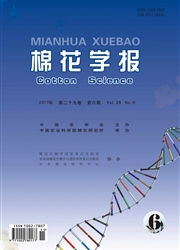

 中文摘要:
中文摘要:
以陆地棉(Gossypium hirsutum L.)品种中棉所8号和海岛棉(Gossypium barbadense L.)品种Pima 90-53杂交产生的包含91个单株的BC1F2群体及其衍生BC1F2:3群体为材料,利用逐步多元回归分析确定分子标记与重要农艺性状的相关关系,为分子标记辅助选择提供依据。试验材料分别种植在保定市郊和沧州青县两个点,每个株行考察衣分、子指、铃重、皮棉重、子棉重5个产量性状和2.5%纤维跨距长度、马克隆值、纤维整齐度、纤维伸长率、纤维比强度5个品质性状。以20对AFLP引物组合产生的125个位点对10个重要农艺性状进行多元线性回归分析,发现其中4对引物组合产生的15个位点与10个性状有着显著相关性(P≤0.05,P≤0.01),而后通过逐步多元回归分析获得6个位点,对9个农艺性状所解释的表型变异为6.2%~30%。结果表明,与9个农艺性状显著相关的6个AFLP位点可以用于未来的分子标记辅助育种计划。
 英文摘要:
英文摘要:
In this study, we designed AFLP(Amplified fi'agment length polymorphism) markers associated with important agro- nomic traits using 91 BCjF2 plants derived from an interspecific cross between Gossypium hirsutum cv. CCRI 8 and G. bar- badense cv. Pima 90-53. Ninety-one rows of BCIF2:3 plants were grown in the fields at Baoding suburban, Qingxian County, Hebei Province, China. The rows were scored for five yield traits-lint percentage, seed weight, boll weight, lint weight, and seed cotton weight, and five fiber quality traits-2.5% span length, micronaire, fiber uniformity, fiber elongation, and fiber strength. To provide a theoretical basis for marker-assisted selection, correlations between molecular markers and agronomic traits were test- ed by stepwise multiple linear regression analysis. Based on the regression analysis, 125 loci from 20 AFLP primer combinations were correlated with the 10 measured traits, although the correlations were only significant (P 〈 0.05, P 〈 0.01) for 15 loci from 4 primer pair combinations. In addition, six loci were associated with 6.2%-30% of the phenotypic variability observed in nine traits. Our results indicate that these AFLP markers should be useful for molecular marker-assisted selection in future cotton breeding.
 同期刊论文项目
同期刊论文项目
 同项目期刊论文
同项目期刊论文
 期刊信息
期刊信息
